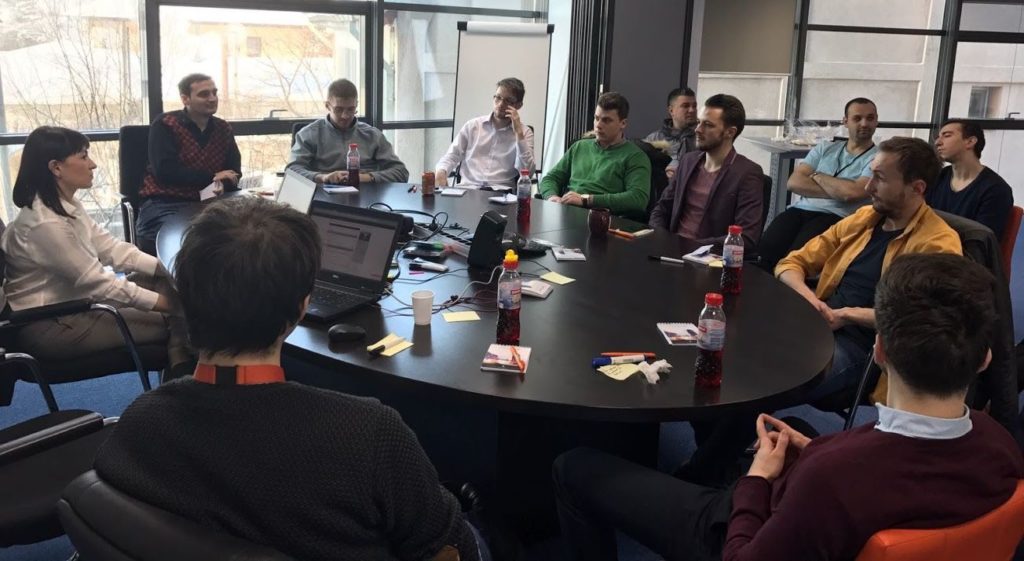A Product Owner is responsible for motivating their team and making sure everyone stays on track – but how do you make sure the job gets done? Harmony.

Happy teams are productive. Meet Pentalog’s teams if you want to enjoy working with efficient people. Contact us now!
Harmony is the essential ingredient in the proverbial goal achievement pie shared by all team members. With the addition of this ingredient, stakeholders’ needs are met and everybody is happy. Not all teams function perfectly and this is completely normal, but it is the Product Owner’s main goal to strive for team cohesion because a happy team is a productive one.
In my previous article from the series dedicated to Product Owners, I explained what Product Owners do, outlined their responsibilities and broke down the skills required to achieve leadership greatness. In this article I’ll delve deeper into the mission of a Product Owner and offer my tips on how to build fruitful relationships with teams and clients based on my work experience and questions I received during the online webinar “A Product Owner’s Life – How to Build a Great Product with a Happy Team”.
A Happy Team is a Strong Team
Every team member’s contribution in the product building process is valuable and trust/communication are key aspects in all professional relationships.
Take for example, the Scrum Master; his/her role is to create a safe environment within the team, celebrate success and listen to everyone.
The PO and SM need to inform each other of any actions they plan to take and make sure they are synchronized. Be open with your SM, share your perspective and point of view, but also listen to him/her and understand the new perspective. It is important not to work against one other. You both represent two sides that will eventually combine.
The SM and PO should also have a strong level of communication in order to stay on the same page. Their responsibilities and focus might be different, but as long as they are perceptive to one another they will each establish and keep a clear delimitation of their perimeters. In turn, they will work complementarily and things will run smoothly.
Apart from the communication with the SM, a PO needs to make sure there is a good communication channel between themselves and the team members. The PO must encourage everyone to communicate any concerns, changes or risks. This way, the Product Owner will be well equipped to manage any interference or upsets.
It is also important to speak openly with the team and encourage them to do the same, but to take responsibility as a leader. Be transparent about where you stand, where you were and where you are headed to as a team. Let them feel the progress with each sprint and communicate the importance of their contribution to the product.
Keep your Team Engaged, even Remotely
Many of us work remotely with clients and even some team members. Sometimes, this type of collaboration can lack the professional intimacy of a face-to-face relationship. To get the team more involved during remote meetings, the PO should challenge them a bit and ask questions, even when talking about team members or different collaborators.
For example, I once needed to work with a UI/UX designer as an external resource, so I did my best to include him in the team through constant communication. Shared understanding is the key. If you make sure the perimeter is covered and clear to everyone, that deadlines/timeline are communicated and planning is known by everyone, everything will works to everyone’s advantage regardless of the type of contract.
With respect to remote collaboration with team members, you can find some ideas and approaches below to help you overcome the disadvantages of remote meetings and ensure everyone is involved and contributing.
If there is one thing a developer hates it’s not having enough detail or specs to be able to gauge or fully understand a story. Use this fact as a basis for your approach.
With that being said, engage your team by:
-
Presenting a story for refinement, but not providing all the details (just a general idea) and ask the team for help.
-
Ask their opinion on how to proceed not only in terms of technical implementation, but also in terms of the feature itself. This can catalyze their involvement in the subject more, they will start asking questions themselves and the communication loop will continue.
-
Lay out one idea and then ask if they might have an even better one. From that point on, conversations have already started and you can move towards more detailed explanations because they are already in the debate mood.
-
It is important to highlight their contribution to the story and the product as well, reiterate that their opinion is important to and remind them of the main features you would like them to focus on, i.e performance, speed or UI/UX.
-
Don’t forget about the “why” behind the story, why the user needs that feature, and how it solves a problem. This will help their focus on the client.

Our Agile managed teams have regular meetings to discuss the progress of each sprint.
Another element that was helpful for us, at Pentalog, was to try and provide estimations during the refinement. This definitely drives the team to ask more questions for clarification and move discussions forward.
Earn Your Clients’ Trust
Great communication with stakeholders contributes to the successful mission of a PO. In this way shared understanding is achieved and the vision is communicated clearly to the PO and then directed towards the team.
In order for the obstacles to be overcome, a PO must have the stakeholders’ trust as well as the teams’.
Of course, it is not easy to build that trust. Here are several ways in which you, as a PO, can build trust:
-
Get to know your stakeholders
-
Keep your word
-
Honest communication – tell the truth & admit when you are wrong
-
Transparency – with decisions, directions & possible solutions
-
Constant feedback in both directions – stakeholders and team
Do everything you can to keep the stakeholders’ trust after you have earned it. It is important in your subsequent interactions to ensure the success of the product.
There are quite a lot of tools out there that can help you build these relationships both with the team and the stakeholders. There are also lots of resources to find even more approaches, solutions or ideas to try out with your team or even by yourself to become a better PO. Stay tuned for my next article where I’ll share some of the tips and tricks I’ve learned along my own journey to become a next-level PO.
Watch the replay of the webinar I hosted.
Discover our teams’ success: a strong team and a passion for IT.









